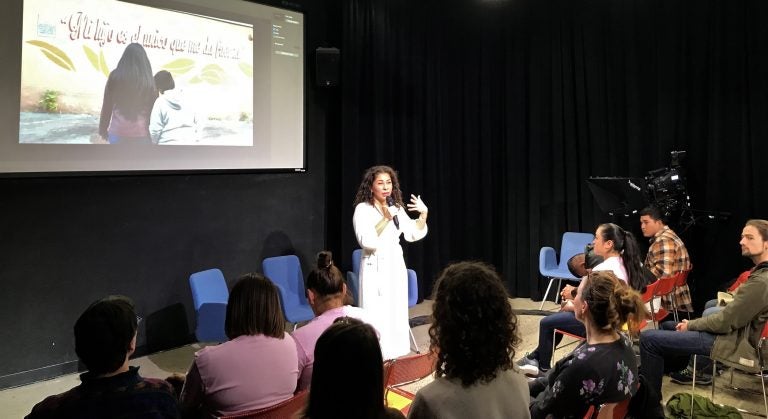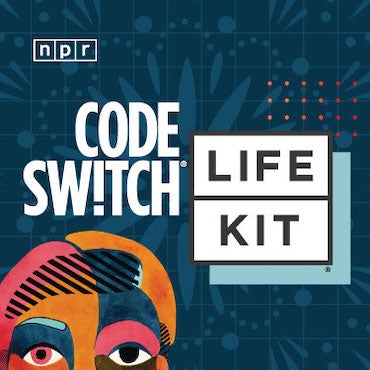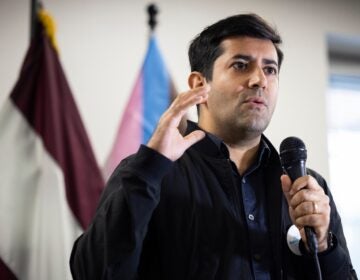Three years after famous hunger strike, las Madres Berks reunite to grieve one of their own
After spending nearly two years in the Berks Family Residential Center, Maria Martinez Nolasco was released. Then she was killed.
Listen 3:34
Visual artist and filmmaker Michelle Angela Ortiz hosts a screening and memorial service dedicated to Maria Martinez Nolasco at PhillyCAM. (Laura Benshoff/WHYY)
In a windowless space at a television studio in Philadelphia, las Madres Berks came together to remember their friend.
The women linked hands around a white column topped with a bouquet of pink roses. Behind them, a screen showed a picture of Maria Martinez Nolasco, flanked by more flowers.
Having survived gangs, the journey to the United States, and years of immigration limbo, they now faced the loss of one of their own.
The Berks Family Residential Center, outside Reading, has been a site of protest for years. Las Madres Berks, as the group of about two dozen former residents call themselves, were ardent critics from inside the immigrant family detention center until some of them won their release in 2017, after nearly two years in federal custody.
In the center, the women bonded, watching one another’s children, convening church services, and even holding a hunger strike that drew national attention in 2016 to protest the terms of their detention.
They had left Central America to escape different forms of gang- and gender-based violence, such as pressure to become involved romantically with gang members, or extortion schemes targeting single mothers. All had expressed a fear of returning to their home countries but were initially denied the opportunity to proceed in the asylum process.
Deadly reality at home and the hope for their children abroad spurred them on, even as doors around them closed. Many were deported. A handful — including Martinez Nolasco — were able to stay in the United States while they pursued other legal ways to remain.
Then on Dec. 10, 2018, domestic violence claimed Martinez Nolasco while she was living in Fredericksburg, Virginia. Her brother was charged with her murder, as well as the attempted murder of his girlfriend, who was pregnant. His trial has been pushed into 2020, according to court records.
“No one expected that Maria wouldn’t be here this Christmas,” said one of the mothers, who asked to be identified as “Sofia” and not her real name, to protect her family from retaliation in El Salvador. “It’s difficult to see us all together without her. She was our comrade. She was our warrior mother.”
Her death underscores an uncomfortable reality: Central America, the Caribbean and South America have the highest violent death rates for women, according to the Small Arms Survey, a Switzerland-based research group that tracks armed violence. Against that backdrop, the U.S. tried to tighten asylum regulations in 2018, making it more difficult to apply for legal status in this country on the basis of gang-related or domestic violence. “Asylum was never meant to alleviate all problems, even all serious problems,” said then-Attorney General Jeff Sessions.
Those changes were blocked by a federal judge and are now under appeal.
But data from the Small Arms Survey shows another trend as well: While the overall murder rates may be lower in wealthier countries, women are still more likely than men to die by violence in Europe and North America. Martinez Nolasco wasn’t safe here, either.
After living through so much together, Sofia said the only way to make sense of more heartbreak is to turn to her faith.
“It’s a hard pain, but we have to deal with it and keep going, because we don’t know God’s plans,” she said.
Remembering ‘an exemplary mother’
Most of the original families in las Madres Berks were deported in 2017. The handful that remain in the United States scattered after their release from detention and began carving out new lives while waiting for answers in their or their children’s immigration cases.
After her stint at the Berks center, Martinez Nolasco, who fled El Salvador after a gang member pursued a relationship with her, had moved to Virginia to be near family there. She was excited that her son would be in school, and friends say she was recently engaged at the time of her death.
To attend the memorial on a recent Saturday in Philadelphia, one family flew in from Houston; another drove down from Long Island.
After a screening of the short documentary “Las Madres de Berks,” which features Martinez Nolasco, her son and three other mothers with their children, they took turns remembering her. Muffled sobs filled the room before the film ended.
“I am happy and sad at the same time,” said Sofia. Happy to be with friends again, but sad “because we’re missing one of the mothers who fought alongside of us,” she said.
“She will always be in our hearts. We will remember her as an exemplary mother. Her son was the number one thing in her life, and I know right now she is protecting him,” said Wendy Osorio Martinez, another mother who was detained at Berks at the same time.
Visual artist Michelle Angela Ortiz, the filmmaker behind “Las Madres de Berks,” organized the gathering, which was open to the public, with the backing of philanthropist Julia Fleischner. The film blends first-person narratives from women held at the center during and after their detention, with advocacy aimed at pushing elected officials to close the center.
The oldest of three family immigrant detention centers in the United States, the Berks center has recently come under fire from the Pennsylvania auditor general, and Gov. Tom Wolf’s administration is in talks with the Berks County Commissioners to figure out a different use for the facility. At the same time, President Donald Trump has called for expanding the practice of long-term family detention, over objections from child welfare experts who say it causes psychological harm.
The film ends with Martinez Nolasco standing in front of a mural of herself and her 10-year-old son, which Ortiz painted in the Allison Hill neighborhood of Harrisburg.
“What helps me is that final image of her standing in front of the mural because if I start thinking about everything else that has happened, it’s very unjust. I get angry,” said Ortiz. As a part of the public art project, the artist included a quote from Martinez Nolasco: “Mi hijo es el único que me da fuerza,” or, “My son is the only one who gives me strength.”
When she first showed the finished piece to Martinez Nolasco, Ortiz said the woman responded, “‘Oh, you made me so large!’ And I said, ‘I made you as large and as grand as you are.’”
Ortiz said her hope was to create a space for healing and community for both the mothers and Martinez Nolasco’s son.
Though less active in campaigning against family detention than they were during their stay in it, the women’s personal stories continue to mingle with the politics of immigration detention.
“My wish is that the center is closed and that no mother or father has to go through what we went through,” Sofia told the audience assembled at PhillyCam.
“My son spent half of his life detained in that prison,” said Osorio Martinez.
After the screening, the families and the 50 people who came to watch the documentary shared empanadas and other traditional foods prepared by Ortiz’s mother. The families retreated to the PhillyCam green room to plan their next move while their kids played.
They keep in touch regularly, on Facebook and on the phone, and time together is a treat. Before the screening, the families had gone to the Franklin Institute. The mothers contemplated going dancing sans kids, or to the City Hall Christmas market afterward.
“We’ll see what we can do to distract ourselves a little bit,” said Sofia. “You have to try, after the pain.”
WHYY is your source for fact-based, in-depth journalism and information. As a nonprofit organization, we rely on financial support from readers like you. Please give today.




